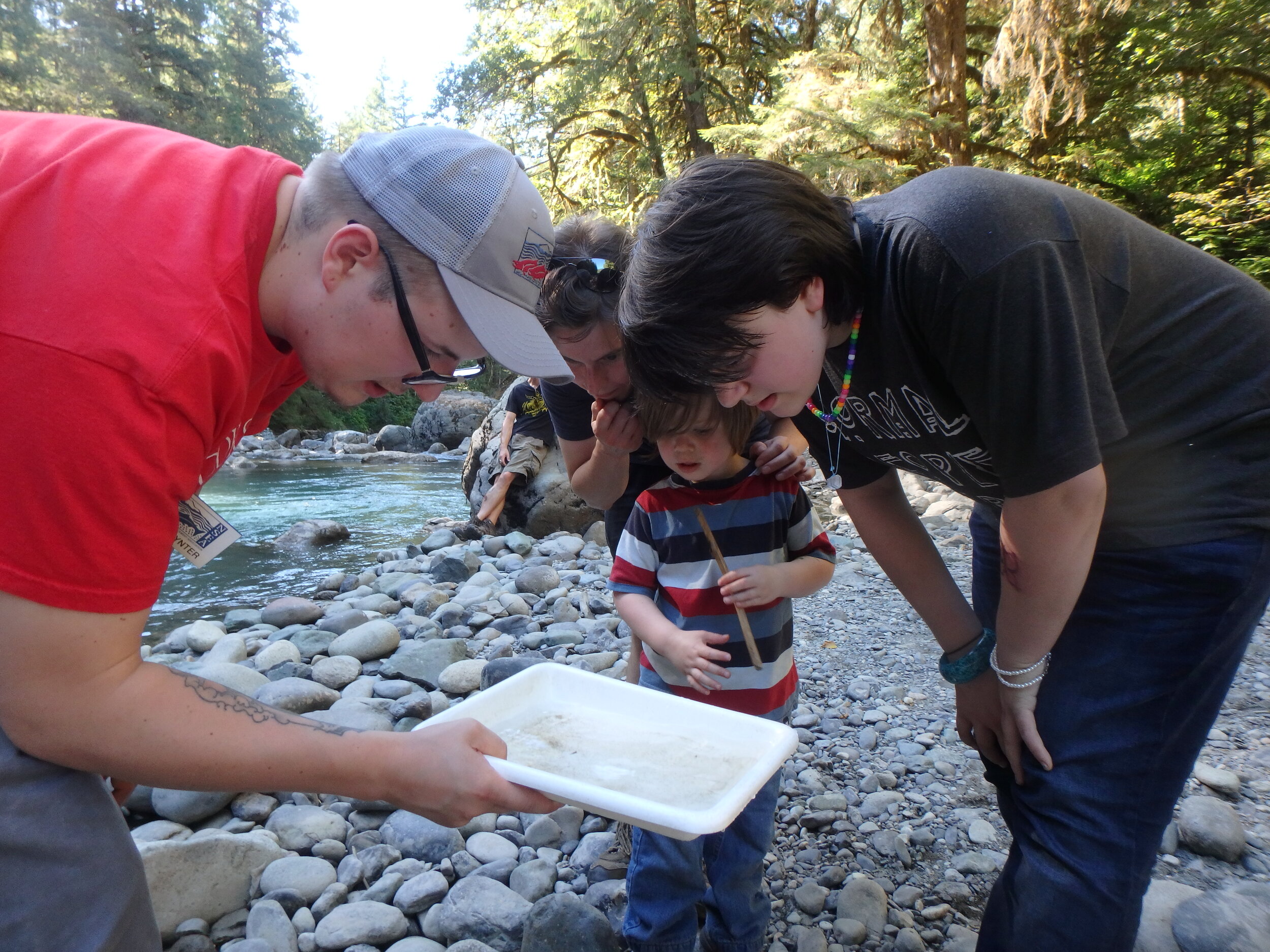By Sarah Brown & Lorraine Wilde
Visitors learn about macroinvertebrates from NSEA River Stewards Intern, Alexandra Watt, in 2019 on the Horseshoe Bend River Walk along the Nooksack River in Glacier, WA.
If you spend any time at all in the Pacific Northwest, you’ll see evidence all around that wild salmon are the backbone of our environment, culture and economy. Yet many salmon-bearing streams have been degraded by past land use practices—the removal of large woody debris and riparian vegetation, the straightening and ditching of stream channels and the installation of poorly designed stream crossings to name just a few. Since the first white settlers, Henry Roeder and Russell Peabody, arrived in Bellingham in 1852, those practices have endangered the quantity and diversity of salmonid habitat regionally and specifically within Whatcom County watersheds. But local nonprofits today are making a difference—one stream and one person at a time.
Over the past 30 years, Nooksack Salmon Enhancement Association (NSEA) has worked diligently with the Lummi Nation and Nooksack Tribes, federal, state, and local agencies and hundreds of private landowners to improve these streams by removing fish passage barriers and improving existing riparian and instream habitat. But restoration efforts alone are not enough. Without public education and continuing community action, we risk losing our wild salmon populations and their fundamental role in the food web and our shared maritime heritage forever.
That’s why NSEA has developed three education programs to provide place-based science education and stewardship opportunities for students, educators and the entire community. NSEA’s Students for Salmon program combines nearby field restoration activities with two classroom visits for all fourth graders in Whatcom County. NSEA’s Future Leaders of Whatcom Waters (FLOW) Internship program allows interns to gain valuable real-world professional experience while increasing on-the-ground work capacity. But the way that most locals and thousands of visitors encounter NSEA is through its Nooksack River Stewards Program. Each summer NSEA partners with the U.S. Forest Service in the Mt. Baker-Snoqualmie National Forest to foster enthusiasm for salmon while respectfully recreating in the North Fork Nooksack River to ensure this special area remains ideal habitat for salmon.
While the specifics of the program change from year to year depending on the needs of the community and NSEA’s community partners, the objective remains the same: increasing knowledge and awareness of how to protect Pacific salmon and their habitat through fascinating, family-friendly educational opportunities. Each unique event allows NSEA to engage with a larger variety of community members and visitors while providing a memorable opportunity to learn more about salmon and stewardship.
DEEP ROOTS IN THE COMMUNITY
NSEA hired its first staff in 2001, then working under the name Nooksack Samish Regional Fisheries Enhancement Council. Since then it has grown to include a team of more than 20 staff, interns and crew members with support from a diverse array of 16 Board members representing a wide range of community interests.
Nooksack River Stewards first began in 2005 as a monitoring program—focused primarily on protecting spring Chinook. But over time the program evolved into a community-focused outreach initiative where staff and volunteers engage with an average of 2,500 individuals each year, totaling nearly 38,000 contacts over the last 15 years.
The program’s focus—the glorious Nooksack River—is one of only two rivers in Washington State that supports runs of all five Pacific salmon species. Its headwaters lay in the magnificent Mount Baker-Snoqualmie National Forest, among the most visited national forests in the country.
NOOKSACK RIVER STEWARDS IN ACTION
By maintaining a consistent presence in the Mount Baker-Snoqualmie National Forest each summer, Nooksack River Stewards fosters a deeper connection between the local residential communities and the critical habitat in their backyards, while also increasing the U.S. Forest Service’s capacity to educate visiting recreators about salmon in our area.
Nooksack River Stewards reaches out—and hooks—summer vacationers through entertaining hands-on activities. For example, one of the most appreciated summertime activities may be sitting by a campfire and roasting marshmallows. The River Stewards have embraced this fun tradition by hosting Campfire Stories. Through partnerships with nearby campgrounds and local businesses, they invite campers and local residents to listen to a salmon storybook or the history of the Nooksack River while enjoying free s’mores around the campfire.
Right across from one of these popular campgrounds is the Horseshoe Bend Trail which runs parallel along the North Fork of the Nooksack River for a little over a mile before ending in a horseshoe-shaped loop. This relatively short, accessible trail is ideal for the River Stewards’ Guided River Walk, which includes a look at water quality on a picturesque gravel bar through hands-on experiments and a collection of macroinvertebrates.
Through collaboration with local rafting companies, River Stewards Interns also connect with soon-to-be whitewater rafters just before they put in. They learn about the significance of the habitat they are about to careen through. Within this two-minute informal presentation on the five types of salmon, these groups—who usually contain a handful or more of out-of-staters—gain a better understanding and connection to the river that is home to these critical and endangered species.
Not only is this program beneficial for increasing the general knowledge and awareness of the general public, it also provides unique opportunities for FLOW Program Interns who participate as naturalists. That synergy provides them with real-world experience in public speaking, community outreach and education. By training them to act as NSEA Naturalists and providing consistent opportunities to practice and engage with people from all over the world, they can better succeed as future educators both locally and beyond.
By working directly with U.S. Forest Service district rangers and coordinators, interns also gain the chance to network with career professionals in both natural resource management and environmental education.
Although most 2020 events were cancelled by the pandemic, Nooksack River Stewards is looking forward to another summer in the forest. Because it is an odd year, the Nooksack River pink salmon that spawn every two years will be returning this summer to spawn their next generation. This gives interns a unique opportunity to not only talk about salmon but also show people directly what NSEA is working to protect.
“Just seeing salmon in person in the river can have a significant impact on visitors,” explains NSEA Stewardship Program Coordinator Sarah Brown. “What we are encouraging people to care about is right there in front of them. Through Salmon Sighting Events and fun salmon-themed resources and activities, we can showcase the whole reason why we do the work we do. And what better place to do it than one of the most popular recreation sites in Western Washington?”
Although the specific programming schedule for summer 2021 will remain flexible in response to the uncertainty imposed by the pandemic, Nooksack River Stewards plan to host Guided River Walks, Campfire Stories, Community Work Parties and Salmon Sighting events. “Regardless of any continuing limitations, we’re eager to return and provide safe, enjoyable opportunities for all to learn about the environment around them,” adds Brown.
LOOKING BACK TO GUIDE WHAT’S AHEAD
This year’s summer celebrations will be extra special as NSEA celebrates its 30th Anniversary. Their legacy lives on each day in local streams. Since 2000, NSEA’s Restoration Program has improved over 35 miles of stream riparian habitat by removing 128 fish passage barriers, improving fish access to over 115 miles of upstream habitat. NSEA also maintains and monitors a minimum of 30 riparian projects each year.
NSEA River Stewards Intern shows a guest the macroinvertebrates that salmon fry eat in the Nooksack River to grow big and strong before heading out to the ocean.
NSEA and the Nooksack River Stewards Program are poised to continue this important restoration and education work in the decades to come. In 2021, NSEA will remove 13 more fish passage barriers, improving access to over 20 miles of upstream habitat, as well as install 17 large woody debris structures and over 21,000 native plants along 7,900 feet of stream channel in Whatcom County.
“We are just visitors here ourselves and all of this hard work feels more like a reward than an effort,” explains NSEA Executive Director Rachel Vasak. “Hearing a community member describe the wonder they experienced as a child over 20 years ago learning about salmon and habitat from NSEA is just one of many rewards. It is a true joy looking up at a tree we planted—once just a tiny seedling but now over 50-feet tall—that shades the stream we’ve cared for. It is here that the Chinook acclimated to the wild as juveniles and now return each spring to spawn a new generation. It just doesn’t get any better than that.”
Over its 30 years, NSEA has completed over 450 restoration projects, planted well over 100,000 trees and educated more than 25,000 students and 38,000 community members and visitors about wild salmon in Whatcom County. You can learn more about the upcoming Nooksack River Stewards Program events, future work parties and 30th Anniversary celebration events, or make a donation today at www.n-sea.org.
SARAH BROWN
Sarah Brown came to Nooksack Salmon Enhancement Association (NSEA) through AmeriCorps in 2018 and joined their staff as the Stewardship Program Coordinator in March 2020. Originally from Texas, Sarah moved to Washington with knowledge and passion for marine and freshwater science. She loves finding new and creative ways to engage and educate the community about salmon and stewardship.
LORRAINE WILDE
Lorraine Wilde has been a freelance writer since 1998, having published more than 250 pieces in blogs, magazines and books. Throughout 30 years in the Pacific Northwest, she’s also been a teacher, actor, filmmaker, environmental scientist, mother and owner of the publicity business, Wilde World Communications. She loves using her business to support the important mission of organizations like NSEA.








